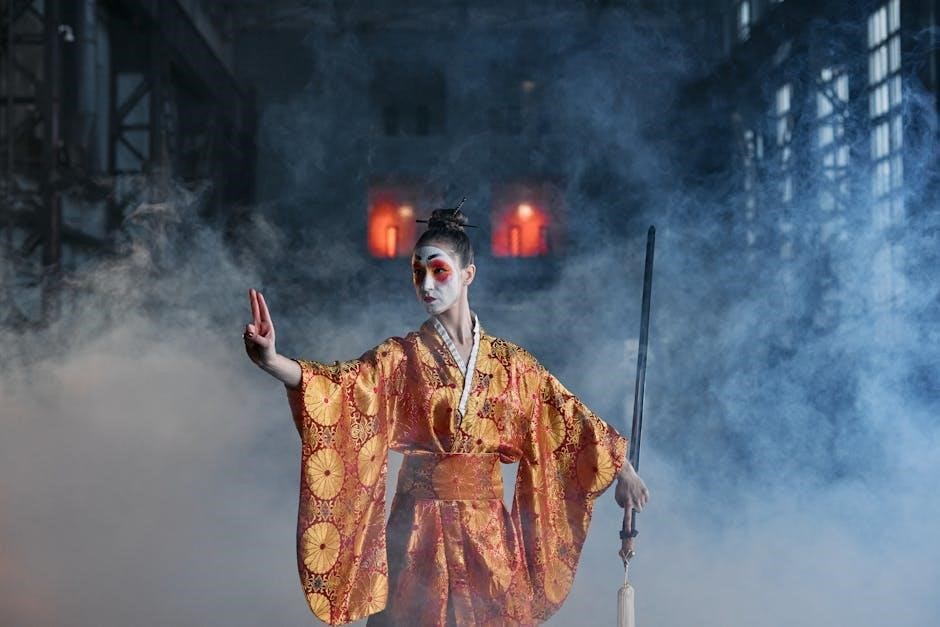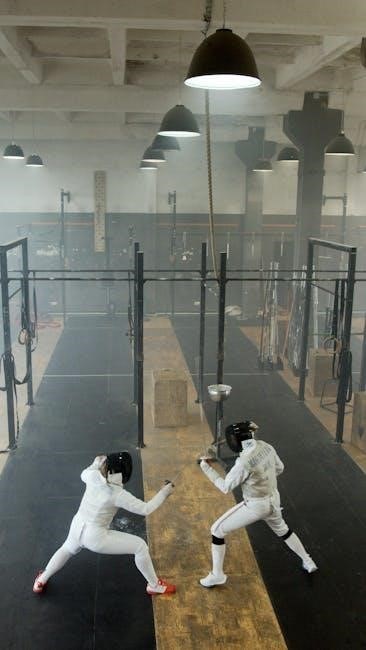The Woman Warrior by Maxine Hong Kingston is a poignant Chinese-American memoir exploring cultural identity, family dynamics, and the transformative power of storytelling, resonating deeply with feminist literature.
1.1 Overview of the Book
The Woman Warrior by Maxine Hong Kingston is a groundbreaking memoir that blends personal narrative with mythology, exploring themes of cultural identity, family, and female empowerment. The book follows a Chinese-American girl’s journey to self-discovery in California, weaving together her mother’s “talk-stories” and mythical tales. Kingston challenges cultural silences, celebrating the strength of women while navigating the duality of her Chinese heritage and American upbringing. The memoir is a powerful exploration of identity, tradition, and the immigrant experience, resonating deeply with readers.
1.2 Author Background: Maxine Hong Kingston
Maxine Hong Kingston, born in 1940 in Stockton, California, is a prominent Chinese-American author; Her unique blend of memoir, mythology, and folklore has redefined autobiographical writing. Kingston’s works, including The Woman Warrior and China Men, explore cultural identity, gender, and immigration. Her writing often reflects the tensions between her Chinese heritage and American upbringing. Kingston’s innovative style has earned her numerous accolades, solidifying her place in both feminist and ethnic literature.
1.3 Historical Context of the Memoir
The Woman Warrior is set against the backdrop of mid-20th-century America, a time of cultural and social change. Kingston draws on her family’s experiences as Chinese immigrants in California, navigating racial discrimination and cultural displacement. The memoir also reflects the historical silencing of women in Chinese culture and the struggles of first-generation Americans to reconcile their dual identities. Kingston’s work bridges personal and collective history, offering a powerful commentary on identity, migration, and resilience.

Key Themes in “The Woman Warrior”
The memoir explores cultural hybridity, storytelling as resistance, and feminism through mythology, while addressing generational gaps and identity struggles between Chinese tradition and American modernity.
2.1 Cultural Identity and Hybridity
In The Woman Warrior, Maxine Hong Kingston delves into the complexities of cultural identity, exploring the tension between Chinese heritage and American assimilation. The protagonist grapples with dual identities, reflecting Kingston’s own experiences as a Chinese-American woman. The memoir highlights the challenges of navigating two cultures, where traditional values clash with modern expectations. Kingston’s storytelling weaves personal and mythological narratives, illustrating the struggle to reconcile cultural hybridity and find belonging in a society that often demands conformity. This theme resonates deeply with immigrant experiences.
2.2 The Role of Storytelling and Mythology
In The Woman Warrior, Maxine Hong Kingston employs storytelling and mythology to bridge personal and cultural narratives. Drawing from Chinese myths and family legends, Kingston creates a tapestry of identity and heritage. The PDF version of the memoir preserves this interweaving of fact and myth, allowing readers to explore themes of empowerment and self-discovery. Storytelling becomes a tool for reclaiming silenced voices and connecting generations, while mythology serves as a backdrop for understanding cultural duality and personal resilience.
2;3 Feminism and Female Empowerment
The Woman Warrior explores feminism through its portrayal of strong, resilient women challenging patriarchal norms. Kingston highlights the struggles of Chinese-American women, emphasizing their strength and resilience. The PDF version underscores the accessibility of these themes, allowing readers to engage with Kingston’s critique of gender roles and her celebration of female agency. By giving voice to silenced women, Kingston empowers them, fostering a deeper understanding of gender dynamics and the importance of female empowerment in both personal and cultural contexts.
2.4 Family Dynamics and Generational Gaps
The Woman Warrior delves into the complexities of family relationships, particularly between generations. Kingston explores the tensions between traditional Chinese values and American cultural influences, reflecting the struggles of immigrant families. The PDF version highlights these dynamics, offering insights into how generational gaps shape identity and cultural adaptation. Kingston’s portrayal of her mother’s stories and her own experiences illustrates the challenges of bridging these divides, emphasizing the impact of family on personal growth and cultural understanding.

Narrative Structure and Style
Kingston’s narrative blends myth, memory, and reality, creating a unique, non-linear structure. Her lyrical prose and symbolic storytelling craft a vivid, layered exploration of identity and culture.
3.1 Blending of Fact and Fiction
In The Woman Warrior, Kingston masterfully blends fact and fiction, merging personal memories with mythological tales. This fusion challenges traditional genres, creating a unique narrative that explores cultural identity and personal history. Kingston’s approach allows her to voice silenced stories, blending historical truths with imaginative storytelling to convey the complexities of her experiences as a Chinese-American woman. This intermingling of reality and myth enhances the emotional and cultural depth of her memoir, making it both deeply personal and universally relatable.
3.2 Non-Linear Narrative Flow
The narrative in The Woman Warrior unfolds non-linearly, reflecting Kingston’s exploration of fragmented memories and cultural dislocation. The memoir shifts between past and present, blending myths, family stories, and personal experiences. This structure mirrors the disjointed nature of Kingston’s identity as a Chinese-American woman, navigating multiple cultural and temporal spaces. The non-linear flow creates a layered, introspective narrative that engages readers in Kingston’s journey of self-discovery and cultural reconciliation, emphasizing the complexity of her hybrid identity.
3.3 Use of Metaphors and Symbolism
Kingston employs metaphors and symbolism to convey the complexities of cultural identity and personal struggle. The “woman warrior” herself is a potent symbol, representing both empowerment and the burdens of cultural expectations. Water imagery, such as the “No Name Woman,” signifies shame and silencing, while the sword symbolizes strength and resistance. These elements enrich the narrative, allowing Kingston to explore themes of identity, gender, and cultural heritage through layered, evocative language that resonates deeply with readers seeking to understand her unique experience.

Major Characters and Their Significance
The protagonist, a Chinese-American girl, navigates identity and cultural conflict. Her mother serves as a bridge between traditions, while the “Woman Warrior” symbolizes resilience and empowerment.
4.1 The Protagonist: A Chinese-American Girl
The protagonist, a Chinese-American girl, embodies the struggles of cultural hybridity and identity. She navigates the complexities of her dual heritage, torn between traditional Chinese values and American societal expectations. Through her journey, Kingston explores themes of self-discovery, cultural conflict, and the search for belonging; The protagonist’s voice reflects the challenges of growing up between two worlds, making her a relatable figure for readers grappling with similar experiences of identity formation and cultural duality.
4.2 The Mother Figure: Cultural Bridge and Conflict
The mother figure in The Woman Warrior serves as both a cultural bridge and a source of conflict. She embodies traditional Chinese values, often clashing with her daughter’s Americanized identity. Her strict adherence to cultural norms creates tension, yet her stories and wisdom provide a connection to the protagonist’s heritage. This dynamic reflects the broader generational and cultural gaps, highlighting the challenges of preserving tradition in a modern, multicultural society while fostering understanding and resilience.
4.3 The “Woman Warrior” as a Symbolic Figure
The “Woman Warrior” symbolizes strength, resilience, and cultural duality in Maxine Hong Kingston’s memoir. This figure, inspired by Chinese mythology, represents the protagonist’s ideal of female empowerment and identity. The warrior embodies the struggle to reconcile traditional values with modern American life, serving as a powerful metaphor for the challenges faced by Chinese-American women. Her legend transcends generations, offering inspiration and a bridge between heritage and personal aspiration.

Analysis of Specific Chapters
This section delves into key chapters like “No Name Woman” and “White Tigers,” exploring themes of cultural identity, silence, and the myth of female strength.
5.1 “No Name Woman” – The Silencing of Female Voices
In “No Name Woman,” Kingston explores the story of her disgraced aunt, whose name was erased due to cultural shame. This chapter highlights the oppressive silence imposed on women, reflecting patriarchal norms and the stigma surrounding female sexuality. Kingston’s narrative challenges these traditions, giving voice to her aunt while examining the tension between cultural identity and personal liberation. The chapter underscores the intergenerational impact of such silencing and the struggle to reclaim forgotten stories.
5.2 “White Tigers” – The Myth of the Warrior Woman
In “White Tigers,” Kingston reimagines the myth of Fa Mu Lan, a legendary woman warrior, to explore themes of identity and empowerment. The chapter juxtaposes the mythical ideal of female strength with the restrictive gender roles Kingston experienced. Through this narrative, she examines the tension between cultural expectations and personal aspirations, highlighting how myths can both inspire and constrain. The warrior woman emerges as a symbol of resilience and cultural pride, yet also underscores the limitations placed on women in reality.
5.3 “Shaman” – The Power of Healing and Voice
In “Shaman,” Kingston explores her mother’s role as a healer and storyteller, emphasizing the power of voice and cultural knowledge. The chapter highlights the tension between traditional expectations and personal expression, as Kingston grapples with her own voice. Through vivid imagery, she portrays her mother as a bridge between past and present, illustrating how storytelling serves as both a healing art and a means of preserving identity; This duality reflects Kingston’s own journey of self-discovery and cultural reconciliation.
5.4 “A Song for a Barbarian Reed Pipe” – Identity and Belonging
This chapter delves into Kingston’s struggle with cultural identity and belonging. She reflects on her childhood experiences, navigating the gap between her Chinese heritage and American surroundings. The reed pipe symbolizes her connection to her roots, while her voice represents her evolving identity. Kingston’s journey highlights the tension of balancing dual cultures, ultimately embracing her unique position as a bridge between traditions, fostering self-acceptance and a sense of belonging in a multicultural world.

Cultural and Historical Significance
“The Woman Warrior” is a landmark work in Chinese-American literature, blending tradition and modernity. Kingston’s memoir explores identity, cultural heritage, and the immigrant experience, resonating universally.
6.1 Representation of Chinese-American Experiences
Maxine Hong Kingston’s The Woman Warrior offers a profound exploration of Chinese-American identity, blending personal narrative with cultural tradition. The memoir captures the complexities of immigration, generational gaps, and the struggle to reconcile dual cultural heritages. Kingston’s work gives voice to the silenced experiences of Chinese-American women, addressing themes of discrimination, cultural displacement, and the challenges of navigating two worlds. By weaving personal and familial stories, Kingston provides a vivid portrayal of the Chinese-American experience, bridging history and modernity.
6.2 The Impact of Immigration on Identity
In The Woman Warrior, Maxine Hong Kingston explores how immigration disrupts and reshapes identity. The protagonist grapples with the tension between her Chinese heritage and American surroundings, reflecting the broader experience of Chinese-Americans. Immigration fosters a sense of displacement, as cultural traditions clash with modern expectations. Kingston vividly portrays the emotional and psychological struggles of navigating dual identities, highlighting the challenges of belonging in a new world while holding onto ancestral roots.
6.3 The Role of Tradition in Modern Life
In The Woman Warrior, Maxine Hong Kingston examines the tension between tradition and modernity, particularly for Chinese-Americans. Traditional values, such as filial piety and gender roles, often conflict with contemporary expectations of individuality and equality. Kingston highlights how these traditions both constrain and empower, offering a connection to heritage while sometimes stifling personal expression. The memoir illustrates the struggle to reconcile ancestral practices with the demands of a rapidly changing world, revealing tradition’s dual role as both burden and bridge.

Literary Reception and Criticism
The Woman Warrior received acclaim for its innovative storytelling and feminist themes but faced criticism for cultural representation. Its impact endures in academic and popular circles.
7.1 Praise for Its Contribution to Feminist Literature
The Woman Warrior is celebrated for its groundbreaking portrayal of women’s experiences, blending personal narrative with mythology. Kingston challenges patriarchal norms and amplifies silenced voices, resonating deeply with feminist scholarship. Critics laud her innovative storytelling for redefining autobiographical writing and empowering women across cultural boundaries. The memoir’s exploration of identity and gender has solidified its place as a landmark text in feminist literature, offering fresh perspectives on intersectionality and cultural heritage.
7.2 Criticisms of Cultural Representation
Some critics argue that The Woman Warrior risks perpetuating stereotypes by blending myth and reality, potentially misrepresenting Chinese cultural practices. Others contend that Kingston’s portrayal of her heritage may cater to Western expectations, exoticizing Chinese traditions. Additionally, the memoir’s focus on personal narrative over collective experiences has led to debates about its representation of Chinese-American identities and its alignment with broader cultural authenticity.
7.3 Academic and Popular Reception
The Woman Warrior has received widespread acclaim for its innovative storytelling and cultural insights. Academically, it is celebrated for blending memoir with mythology, challenging traditional genre boundaries. Popularly, it resonates with readers exploring identity and cultural duality. The book has been adopted in classrooms and praised for its lyrical prose, making it a landmark in both feminist and Asian-American literature while appealing to a broad audience seeking nuanced cultural narratives.

Autobiographical Elements
Maxine Hong Kingston weaves her own childhood, family stories, and cultural identity into the memoir, blending personal experiences with folklore to explore themes of belonging and heritage.
8.1 Kingston’s Own Experiences in the Memoir
Maxine Hong Kingston draws heavily from her personal life, weaving childhood memories, family interactions, and cultural struggles into the narrative. Her experiences as a Chinese-American woman in California, grappling with identity and tradition, form the emotional core of the book. Kingston’s own struggles with language, cultural expectations, and generational gaps are vividly portrayed, offering a deeply personal lens through which universal themes of belonging and resilience are explored.
8.2 The Influence of Family Stories and History
Family stories and history deeply shape Kingston’s narrative, as her mother’s tales of ancestors, myths, and cultural traditions serve as both inspiration and conflict. These stories, often fragmented and layered, reflect the complexities of cultural transmission. Kingston grapples with their meaning, questioning their accuracy while embracing their emotional resonance. They form a bridge between her Chinese heritage and American upbringing, influencing her exploration of identity and belonging in the memoir.
8.3 The Process of Self-Discovery
In The Woman Warrior, Kingston’s journey of self-discovery intertwines personal and cultural narratives. Through fragmented memories, myths, and family histories, she navigates the tensions between her Chinese heritage and American identity. The memoir becomes a space for reclaiming her voice and reconciling contradictions, ultimately empowering her to define herself. Kingston’s exploration is both deeply personal and universally relatable, offering insights into identity, belonging, and the complexities of cultural hybridity.

The Role of Language and Voice
Language and voice are central to Kingston’s exploration of identity, serving as tools to bridge cultural divides and challenge silence. Her narrative underscores the transformative power of speech in reclaiming and asserting selfhood.
9.1 The Power of Silence and Speech
In “The Woman Warrior,” silence and speech are potent forces shaping identity and cultural negotiation. Kingston explores how silence, often imposed by cultural norms, can suppress individuality and perpetuate oppression. Conversely, speech emerges as a means of empowerment and self-definition, allowing the protagonist to reclaim her voice and bridge the gap between her Chinese heritage and American reality. The interplay between these forces underscores the memoir’s themes of identity, cultural duality, and personal liberation.
9.2 Language as a Tool for Identity Formation
In “The Woman Warrior,” language serves as both a bridge and a barrier, reflecting Kingston’s struggle to reconcile her Chinese heritage with her American upbringing. The memoir highlights how language shapes identity, with Kingston navigating the complexities of bilingualism and cultural translation. Through her narrative, she asserts the power of words to reclaim and redefine selfhood, blending the rhythms of Chinese storytelling with the directness of American speech to forge a unique voice.
9.3 The Struggle with Bilingualism
Kingston’s narrative often reflects her complex relationship with language, particularly the tension between her Chinese heritage and American surroundings. The struggle with bilingualism is evident as she navigates the poetic richness of Chinese and the directness of English. This duality mirrors her broader identity conflict, where language becomes both a bridge and a barrier. Her experiences highlight the emotional and psychological challenges of balancing two linguistic worlds, often leading to moments of disconnection and self-doubt.

The Significance of the PDF Version
The PDF version of The Woman Warrior offers a convenient, accessible format for readers, preserving the original text’s integrity while enabling easy digital sharing and reference.
10.1 Accessibility and Digital Formats
The PDF version of The Woman Warrior enhances accessibility, offering adjustable font sizes and compatibility with screen readers. Digital formats ensure widespread availability, making the memoir reachable for students, researchers, and global readers. The PDF preserves the original text’s formatting while allowing for easy sharing and storage. This digital accessibility aligns with modern reading habits, ensuring Kingston’s work remains relevant and engaging for a diverse audience.
10.2 The Role of PDFs in Academic and Personal Use
PDFs of The Woman Warrior are invaluable for academic research, enabling scholars to highlight and annotate key passages easily. Students appreciate the portability and accessibility on various devices, facilitating study anywhere. Personally, readers benefit from having a permanent digital copy, allowing for revisits and deeper engagement with Kingston’s themes. The format ensures consistency and convenience, making it a preferred choice for both academic and personal enrichment.
10.3 Challenges and Benefits of Digital Access
Digital access to The Woman Warrior offers convenience and accessibility, allowing readers to engage with the text on various devices. PDFs provide portability and ease of use, enhancing the reading experience; However, challenges like copyright concerns and potential eye strain from screen time exist. Despite these issues, digital formats remain a valuable tool for academic and personal use, fostering deeper engagement with Kingston’s work while addressing modern reading preferences and technological advancements.
